Alexander Schperberg
Energy-Efficient Motion Planner for Legged Robots
Mar 08, 2025Abstract:We propose an online motion planner for legged robot locomotion with the primary objective of achieving energy efficiency. The conceptual idea is to leverage a placement set of footstep positions based on the robot's body position to determine when and how to execute steps. In particular, the proposed planner uses virtual placement sets beneath the hip joints of the legs and executes a step when the foot is outside of such placement set. Furthermore, we propose a parameter design framework that considers both energy-efficiency and robustness measures to optimize the gait by changing the shape of the placement set along with other parameters, such as step height and swing time, as a function of walking speed. We show that the planner produces trajectories that have a low Cost of Transport (CoT) and high robustness measure, and evaluate our approach against model-free Reinforcement Learning (RL) and motion imitation using biological dog motion priors as the reference. Overall, within low to medium velocity range, we show a 50.4% improvement in CoT and improved robustness over model-free RL, our best performing baseline. Finally, we show ability to handle slippery surfaces, gait transitions, and disturbances in simulation and hardware with the Unitree A1 robot.
OptiState: State Estimation of Legged Robots using Gated Networks with Transformer-based Vision and Kalman Filtering
Jan 31, 2024Abstract:State estimation for legged robots is challenging due to their highly dynamic motion and limitations imposed by sensor accuracy. By integrating Kalman filtering, optimization, and learning-based modalities, we propose a hybrid solution that combines proprioception and exteroceptive information for estimating the state of the robot's trunk. Leveraging joint encoder and IMU measurements, our Kalman filter is enhanced through a single-rigid body model that incorporates ground reaction force control outputs from convex Model Predictive Control optimization. The estimation is further refined through Gated Recurrent Units, which also considers semantic insights and robot height from a Vision Transformer autoencoder applied on depth images. This framework not only furnishes accurate robot state estimates, including uncertainty evaluations, but can minimize the nonlinear errors that arise from sensor measurements and model simplifications through learning. The proposed methodology is evaluated in hardware using a quadruped robot on various terrains, yielding a 65% improvement on the Root Mean Squared Error compared to our VIO SLAM baseline. Code example: https://github.com/AlexS28/OptiState
SCALER: Versatile Multi-Limbed Robot for Free-Climbing in Extreme Terrains
Dec 08, 2023Abstract:This paper presents SCALER, a versatile free-climbing multi-limbed robot that is designed to achieve tightly coupled simultaneous locomotion and dexterous grasping. Although existing quadruped-limbed robots have shown impressive dexterous skills such as object manipulation, it is essential to balance power-intensive locomotion and dexterous grasping capabilities. We design a torso linkage and a parallel-serial limb to meet such conflicting skills that pose unique challenges in the hardware designs. SCALER employs underactuated two-fingered GOAT grippers that can mechanically adapt and offer 7 modes of grasping, enabling SCALER to traverse extreme terrains with multi-modal grasping strategies. We study the whole-body approach, where SCALER uses its body and limbs to generate additional forces for stable grasping with environments, further enhancing versatility. Furthermore, we improve the GOAT gripper actuation speed to realize more dynamic climbing in a closed-loop control fashion. With these proposed technologies, SCALER can traverse vertical, overhang, upside-down, slippery terrains, and bouldering walls with non-convex-shaped climbing holds under the Earth's gravity.
Real-to-Sim: Deep Learning with Auto-Tuning to Predict Residual Errors using Sparse Data
Sep 07, 2022
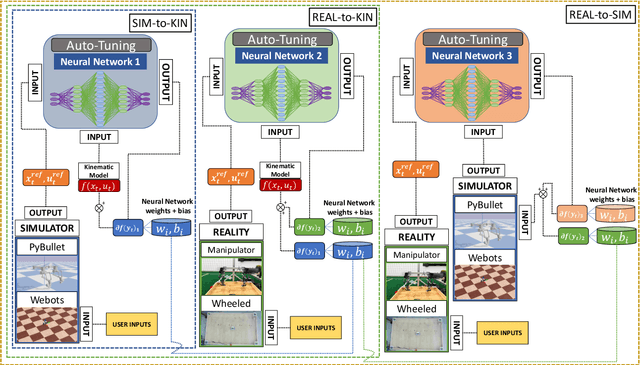
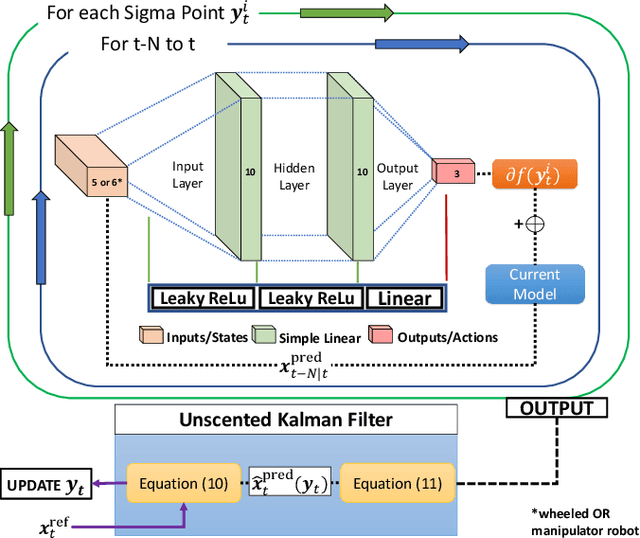

Abstract:Achieving highly accurate kinematic or simulator models that are close to the real robot can facilitate model-based controls (e.g., model predictive control or linear-quadradic regulators), model-based trajectory planning (e.g., trajectory optimization), and decrease the amount of learning time necessary for reinforcement learning methods. Thus, the objective of this work is to learn the residual errors between a kinematic and/or simulator model and the real robot. This is achieved using auto-tuning and neural networks, where the parameters of a neural network are updated using an auto-tuning method that applies equations from an Unscented Kalman Filter (UKF) formulation. Using this method, we model these residual errors with only small amounts of data - a necessity as we improve the simulator/kinematic model by learning directly from hardware operation. We demonstrate our method on robotic hardware (e.g., manipulator arm), and show that with the learned residual errors, we can further close the reality gap between kinematic models, simulations, and the real robot.
Learning Near-global-optimal Strategies for Hybrid Non-convex Model Predictive Control of Single Rigid Body Locomotion
Jul 16, 2022


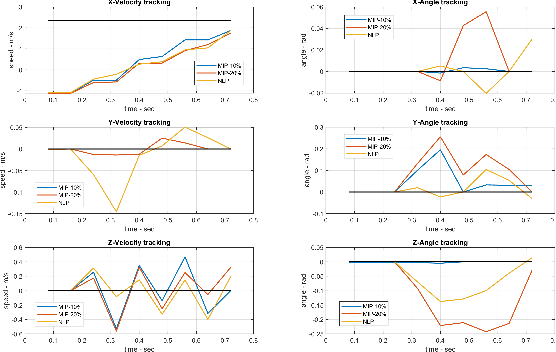
Abstract:Convex model predictive controls (MPCs) with a single rigid body model have demonstrated strong performance on real legged robots. However, convex MPCs are limited by their assumptions such as small rotation angle and pre-defined gait, limiting the richness of potential solutions. We remove those assumptions and solve the complete mixed-integer non-convex programming with single rigid body model. We first collect datasets of pre-solved problems offline, then learn the problem-solution map to solve this optimization fast for MPC. If warm-starts can be found, offline problems can be solved close to the global optimality. The proposed controller is tested by generating various gaits and behaviors depending on the initial conditions. Hardware test demonstrates online gait generation and adaptation running at more than 50 Hz based on sensor feedback.
Auto-Calibrating Admittance Controller for Robust Motion of Robotic Systems
Jul 06, 2022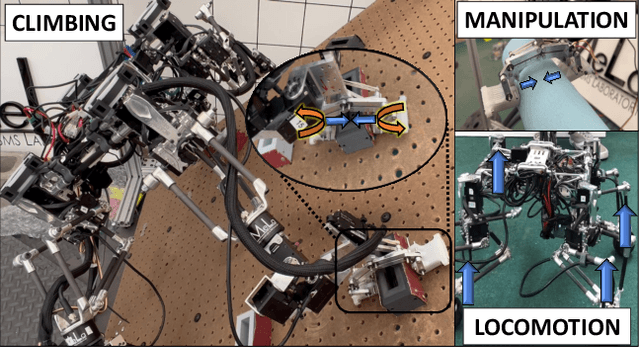
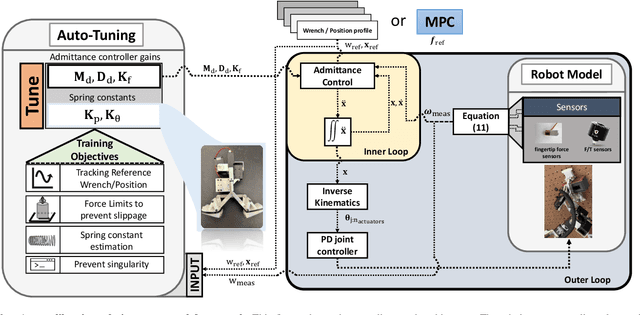
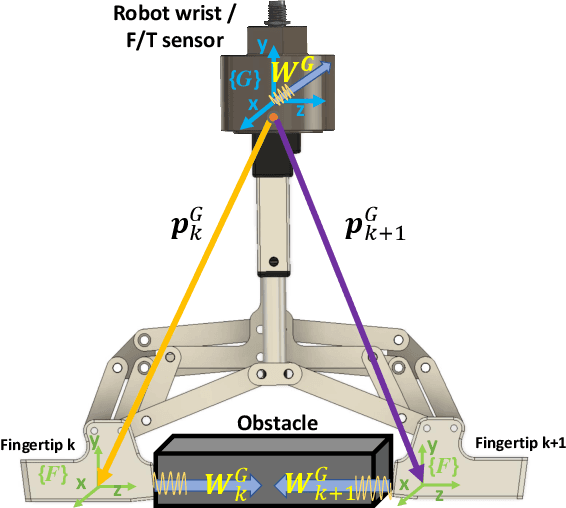
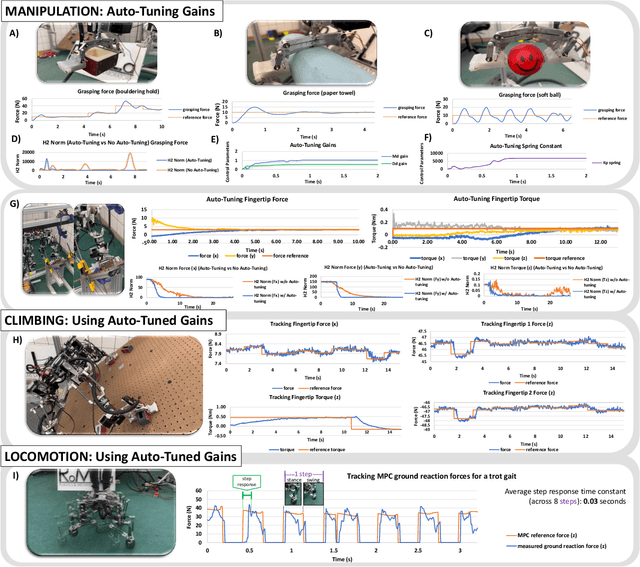
Abstract:We demonstrate an admittance controller with auto-tuning that can be applied for single and multi-point contact robots (e.g., legged robots with point feet or multi-finger grippers). The controller's objective is to track wrench profiles of each contact point while considering the additional torque due to rotational friction. Our admittance controller is adaptive during online operation by using an auto-tuning method that tunes the gains of the controller while following several training objectives that facilitate controller stability, such as tracking the wrench profile as closely as possible, ensuring control outputs that are within force limits that minimize slippage, and avoids kinematic singularity. We demonstrate the robustness of our controller on hardware for both manipulation and locomotion tasks using a multi-limbed climbing robot.
Simultaneous Contact-Rich Grasping and Locomotion via Distributed Optimization Enabling Free-Climbing for Multi-Limbed Robots
Jul 05, 2022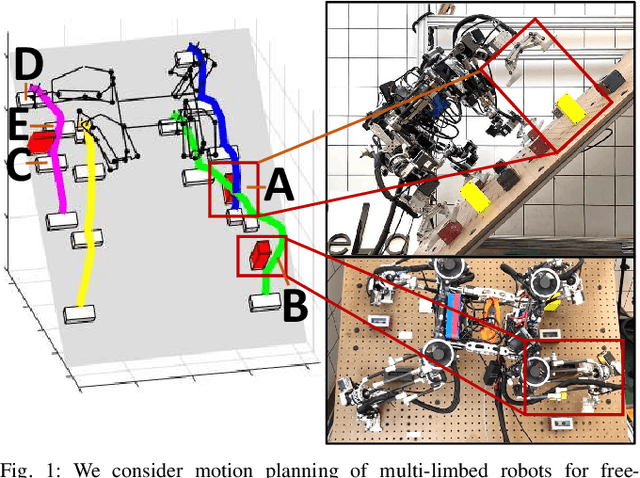
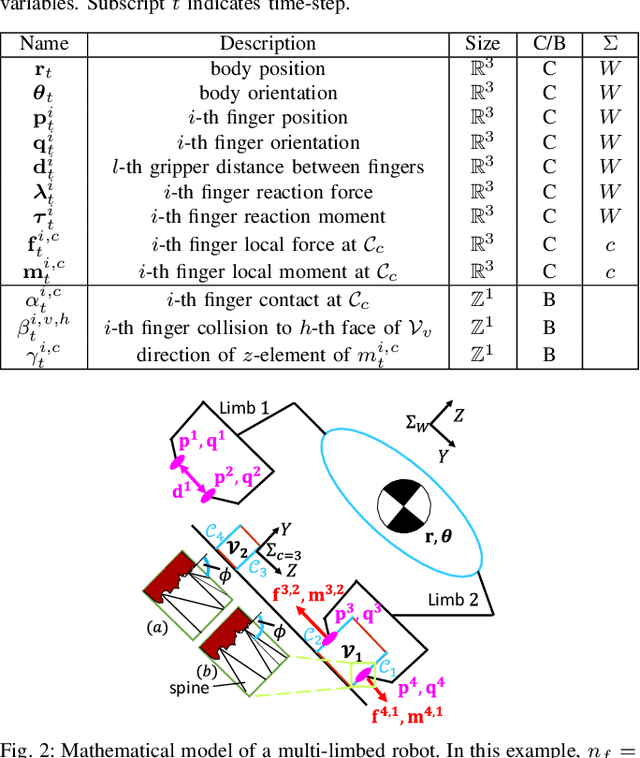
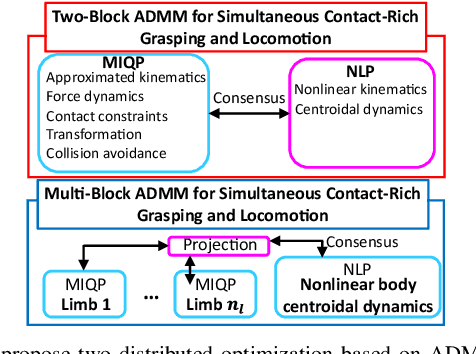
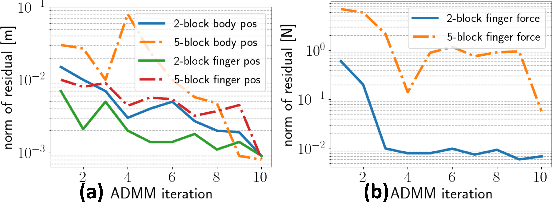
Abstract:While motion planning of locomotion for legged robots has shown great success, motion planning for legged robots with dexterous multi-finger grasping is not mature yet. We present an efficient motion planning framework for simultaneously solving locomotion (e.g., centroidal dynamics), grasping (e.g., patch contact), and contact (e.g., gait) problems. To accelerate the planning process, we propose distributed optimization frameworks based on Alternating Direction Methods of Multipliers (ADMM) to solve the original large-scale Mixed-Integer NonLinear Programming (MINLP). The resulting frameworks use Mixed-Integer Quadratic Programming (MIQP) to solve contact and NonLinear Programming (NLP) to solve nonlinear dynamics, which are more computationally tractable and less sensitive to parameters. Also, we explicitly enforce patch contact constraints from limit surfaces with micro-spine grippers. We demonstrate our proposed framework in the hardware experiments, showing that the multi-limbed robot is able to realize various motions including free-climbing at a slope angle 45{\deg} with a much shorter planning time.
SCALER: A Tough Versatile Quadruped Free-Climber Robot
Jul 04, 2022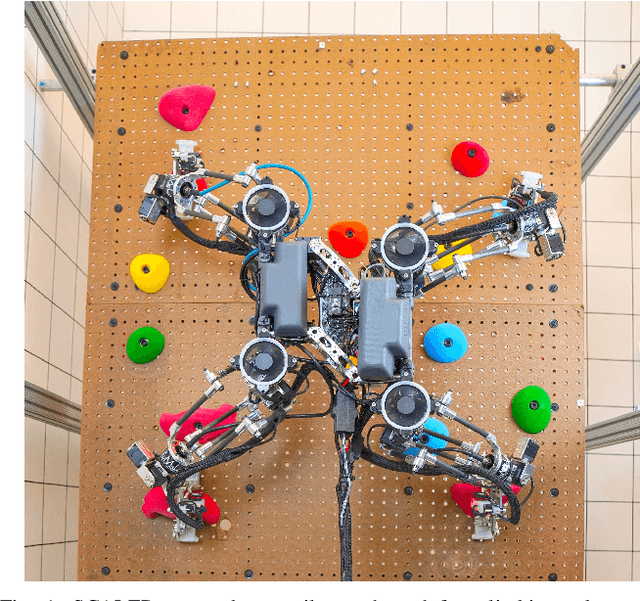
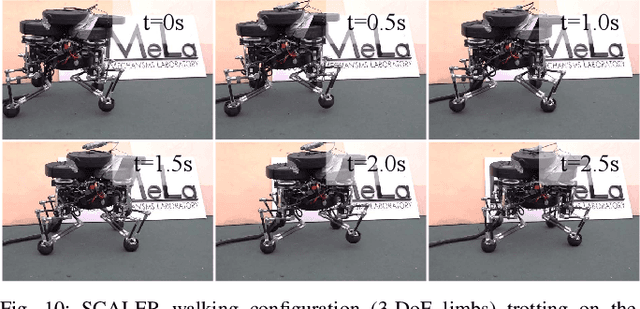
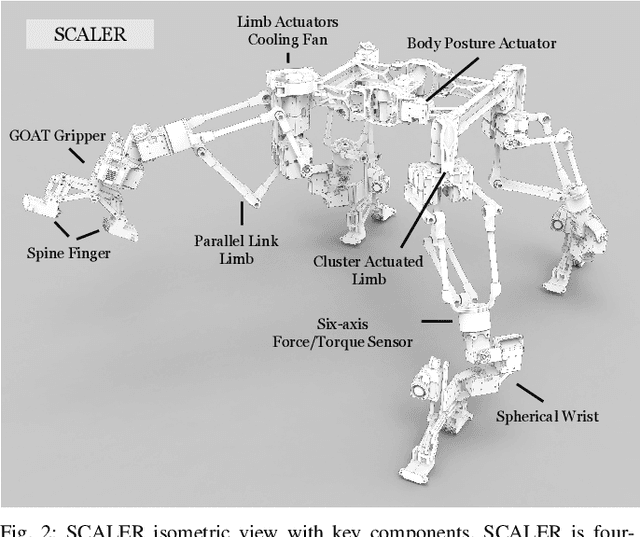
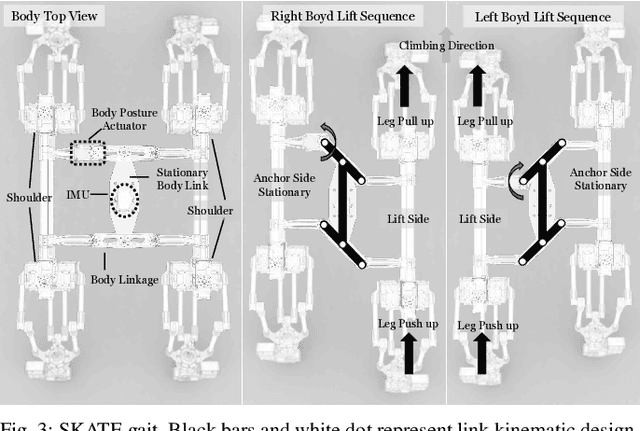
Abstract:This paper introduces SCALER, a quadrupedal robot that demonstrates climbing on bouldering walls, overhangs, and ceilings and trotting on the ground. SCALER is one of the first high-degrees of freedom four-limbed robots that can free-climb under the Earth's gravity and one of the most mechanically efficient quadrupeds on the ground. Where other state-of-the-art climbers are specialized in climbing itself, SCALER promises practical free-climbing with payload \textit{and} ground locomotion, which realizes true versatile mobility. A new climbing gait, SKATE gait, increases the payload by utilizing the SCALER body linkage mechanism. SCALER achieves a maximum normalized locomotion speed of $1.87$ /s, or $0.56$ m/s on the ground and $1.2$ /min, or $0.42$ m/min in bouldering wall climbing. Payload capacity reaches $233$ % of the SCALER weight on the ground and $35$ % on the vertical wall. Our GOAT gripper, a mechanically adaptable underactuated two-finger gripper, successfully grasps convex and non-convex objects and supports SCALER.
SABER: Data-Driven Motion Planner for Autonomously Navigating Heterogeneous Robots
Aug 03, 2021
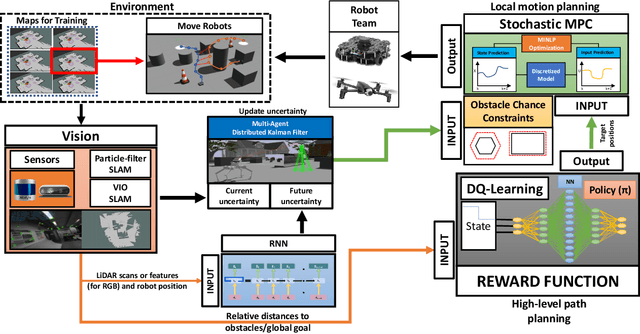
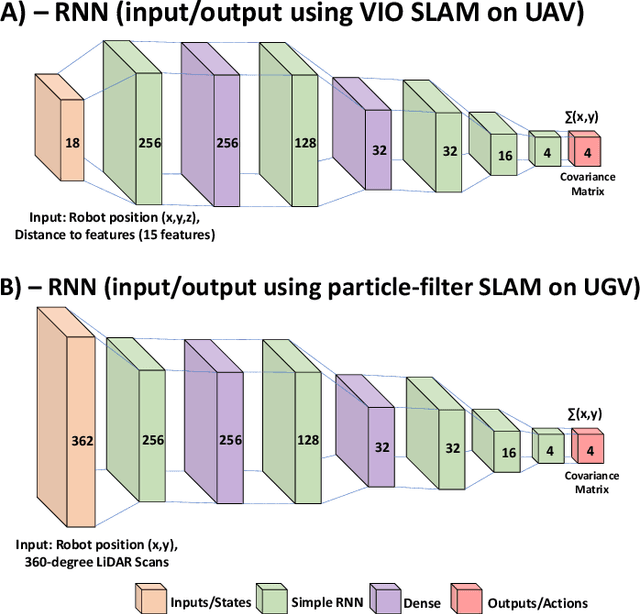

Abstract:We present an end-to-end online motion planning framework that uses a data-driven approach to navigate a heterogeneous robot team towards a global goal while avoiding obstacles in uncertain environments. First, we use stochastic model predictive control (SMPC) to calculate control inputs that satisfy robot dynamics, and consider uncertainty during obstacle avoidance with chance constraints. Second, recurrent neural networks are used to provide a quick estimate of future state uncertainty considered in the SMPC finite-time horizon solution, which are trained on uncertainty outputs of various simultaneous localization and mapping algorithms. When two or more robots are in communication range, these uncertainties are then updated using a distributed Kalman filtering approach. Lastly, a Deep Q-learning agent is employed to serve as a high-level path planner, providing the SMPC with target positions that move the robots towards a desired global goal. Our complete methods are demonstrated on a ground and aerial robot simultaneously (code available at: https://github.com/AlexS28/SABER).
Risk-Averse MPC via Visual-Inertial Input and Recurrent Networks for Online Collision Avoidance
Jul 28, 2020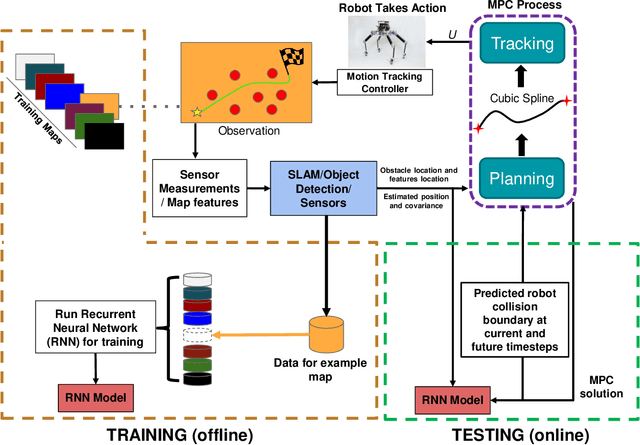
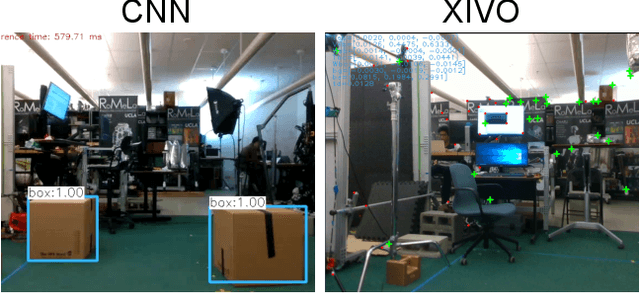
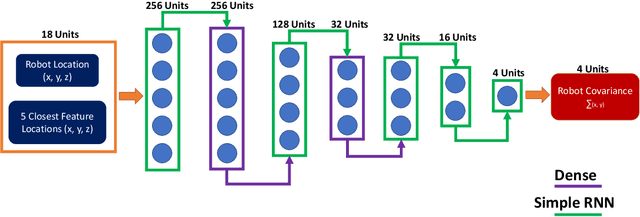
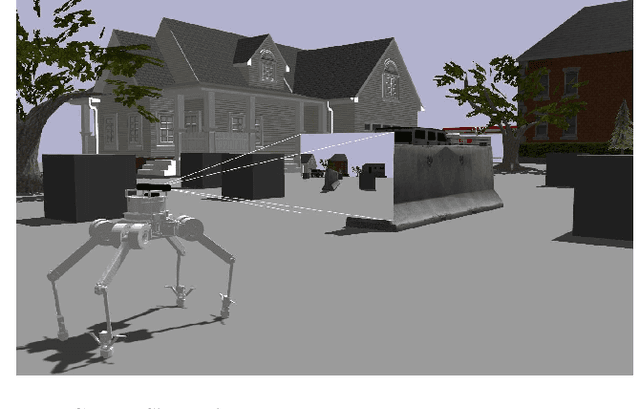
Abstract:In this paper, we propose an online path planning architecture that extends the model predictive control (MPC) formulation to consider future location uncertainties for safer navigation through cluttered environments. Our algorithm combines an object detection pipeline with a recurrent neural network (RNN) which infers the covariance of state estimates through each step of our MPC's finite time horizon. The RNN model is trained on a dataset that comprises of robot and landmark poses generated from camera images and inertial measurement unit (IMU) readings via a state-of-the-art visual-inertial odometry framework. To detect and extract object locations for avoidance, we use a custom-trained convolutional neural network model in conjunction with a feature extractor to retrieve 3D centroid and radii boundaries of nearby obstacles. The robustness of our methods is validated on complex quadruped robot dynamics and can be generally applied to most robotic platforms, demonstrating autonomous behaviors that can plan fast and collision-free paths towards a goal point.
 Add to Chrome
Add to Chrome Add to Firefox
Add to Firefox Add to Edge
Add to Edge